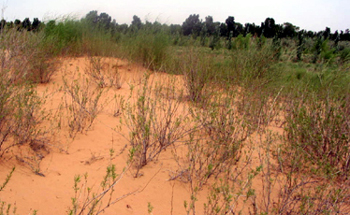| Tools: Save | Print | E-mail | Most Read |
| Desertification Results in US$58.75 Billion Loss |
| Adjust font size: |
A survey of China's 973 Program research project, Deserts and Desertification in China, shows that in recent years the average annual economic loss caused by the destruction of ecosystem and environmental pollution has occupied nearly 14 percent of GDP, according to China Business News of April 18. Such economic losses stood at 420.16 billion yuan (US$52.52 billion) in 1994 and rose to 700 billion yuan (US$87.5 billion) in 2000. These figures do not cover other potential losses relating to animal and plant life. The survey pointed out that environmental protection measures already in place to stop further land degradation should be further improved. In 1998, the National Ecological Environment Construction Program set out the goal: the area of desertification under control to reach 22 million square kilometers by 2010 and 40 million square kilometers by 2030. Yet the northwest China which suffers the most serious desertification problem has a shortage of water resources. Hence the target should not have been set too high before the issue of water shortage is got addressed, according to the survey. Desertification is the main cause of sandstorms. According to Chen Guangting, an expert with the national 973 Program research project on desertification, sandstorms were not only be caused by warm and dry weather but were also closely linked to agricultural development in northwest China.
Deep ploughing, the main cultivation method taken in vast northwestern areas, turned loose and wet soil over onto the surface. Because of the dry weather, this soil lost its moisture content quickly and blew away. The months of March and April are the busiest farming season in northwest China. Wang Tao, chief scientist of the national 973 Program research project on desertification, said, "From the history of sandstorms in Beijing we can draw two conclusions: Firstly they often happen about 30 years after substantial land reclamation and secondly the dry and cold weather make a contribution to its happening." According to the Chinese Academy of Sciences, the potential for sandstorms will be heightened in coming years. Wang Tao said there were four factors to be considered: soil resources were over-utilized; the degradation and reduction of grassland couldn't easily be rectified; water shortages were becoming more serious and the soil was not holding water. As human beings are unable to control the weather yet, said Wang Tao, the key to ease sandstorms and desertification lies in the protection of the ecosystem. The government should strengthen the regulations and also work out policies to forbid any activity which could be harmful to the environment. The 973 Program, launched in 1998, is a national program for the development of basic scientific research. It involves multi-disciplinary, comprehensive research on important scientific issues in such fields as agriculture, energy, information, resources, population, health and materials, providing a theoretical basis and scientific foundations for policy making. The program encourages outstanding scientists to do research in cutting-edge science and in fields with a significant bearing on socio-economic development. (China.org.cn by Wang Ke, April 20, 2006) |
| Tools: Save | Print | E-mail | Most Read |
 |
| Related Stories |
| Product Directory China Search |
Country Search Hot Buys |
